PET OWNERSHIP GREW by leaps and bounds during the pandemic, and also by hops and flights and slithers and swims.
Consider this finding from the recently published Packaged Facts February 2021 Survey of Pet Owners: “23 percent of U.S. households added pets in 2020, with a disproportionately high 6 percent adding pets other than dogs or cats.”
The report also points out that “other pets” have reached a new level of popularity, especially in households with a dog or cat: “For the 12-month period ending February 2021, while 11 percent of current pet-owning households overall added pets other than dogs or cats, 19 percent of those with dogs or cats did so.”
Now consider what Packaged Facts has to say about the desirability of these pet parents as customers: “Multiple-pet households — and especially those adding pets in the midst of a global health crisis — are likely to be relatively economically secure since pet ownership is a highly discretionary expense.” And, “Keeping ‘other pets’ is often a mark of higher-income multiple-pet households.”
So what should pet businesses take away from these findings? That if you only provide products and services for dogs and cats, you are missing out on opportunities not only to attract new customers, but also to meet more needs of existing ones.
With that in mind, we asked members of the PETS+ Brain Squad to share how they go beyond dog and cat. Here are 20 ways, complete with insight and advice.
1. Be Curious
&Convenient
1 Ask dog and cat customers if they have other pets at home, Shelly Nicastro of Essex Bird & Pet Supply in Essex, MA, recommends. If they do, offer to stock what they need to replenish supplies for all of their pets on the same schedule. For example, “Food, treats and bedding are the most-used items with small animals. If you carry just these three categories, you will do well.” And she points out, “If they have to go to another store for their small animals, you may be losing out on dog and cat supply sales as well.” Small animal lines that sell well for her include Oxbow Animal Health and Higgins Premium Pet Foods.
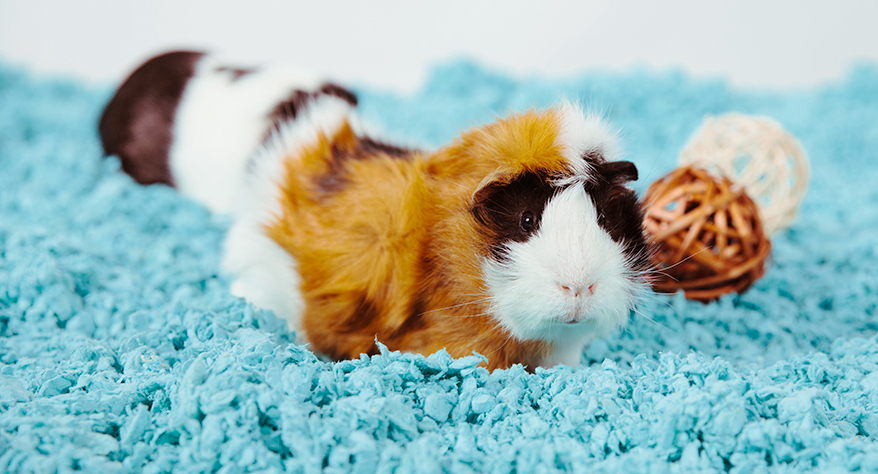
Healthy Pet provides images retailers can use on their websites and social media.
2. Partner with
Supportive Brands
Paula Gorman of Pet Supplies ‘N’ More in Muskego, WI, also suggests Oxbow to retailers new to the small animal category because of its variety, quality and Preferred Store Program. “Oxbow is very supportive. It has buy six, get one free, and all types of information sheets to hand out to customers.” Other program benefits include an online store locator listing, new-owner coupons and employee training.
Small animal brand Healthy Pet takes part in Astro Loyalty, through which it provides a frequent-buyer program, special offers, social content, and other supportive materials such as educational videos.
Lafeber Company has its Family Pet Shop program that allows retailers to order direct and receive free bird and small animal products to help offset shipping costs, with discounts on first orders. Michelle Miller with the company says, “We have trial sizes, window clings and shelf talkers available, and lifestyle images and videos.”
For aquatics, Fluval offers accessibility that suits both retailers and customers new to the hobby. Brand manager Jonathan Hester says stocking basic supplies for fish can keep multi-pet parents from shopping for them online, but that stores can dive deeper into the category by bringing in betta fish. “They are relatively inexpensive and take up a limited amount of space in-store. We just launched a new line of betta-specific products including substrates, décor and even a betta-specific aquarium. We have detailed care guides on fluvalaquatics.com that can be used to educate store staff as well as the new pet parent. This would be everything a retailer would need to get started.”
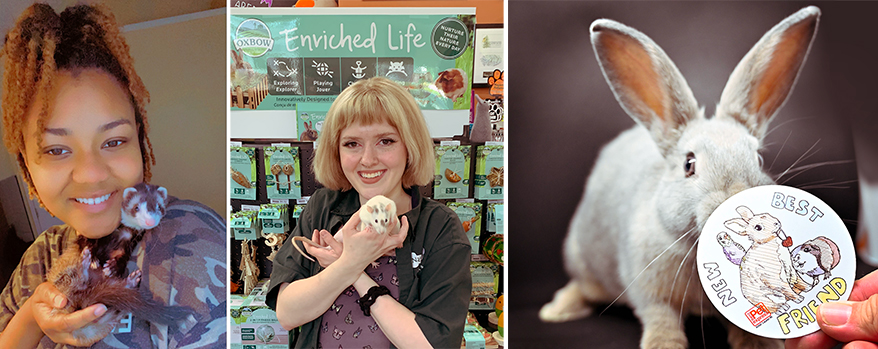
From left, Nyjah Hunter, Maisie Flanagan, and Astro the tester bunny, who stars in a store sticker.
3. Think Outside The
Crate When Hiring
Admittedly, Jennifer Flanagan of Nature’s Pet Market of Sherwood, OR, had an easy hire in her daughter, Maisie, but the results have been outstanding. “Maisie has five rats, and anyone who shops for rodents and rabbits, she shows them our Oxbow end cap and the functions and versatility of the products. Our sales of those products have doubled in the past six months!”
Victoria Park of Park Pet Supply in Atlanta, GA, says, “It is a huge bonus when an employee has experience with pets outside of dogs and cats.” She has such an employee in Nyjah Hunter, who has a ferret named Kodah. “We will add ferret products based on her recommendations. Once the customers meet Nyjah and find out she has a ferret, it definitely encourages repeat customers.”
Stephanie Wright of Bend Pet Express in Bend, OR, touts the benefits of having in-house testers, like Astro the bunny. “Having staff that has owned or currently own small animals, and are open to researching and testing products for these less common customers, helps keep them coming back!”
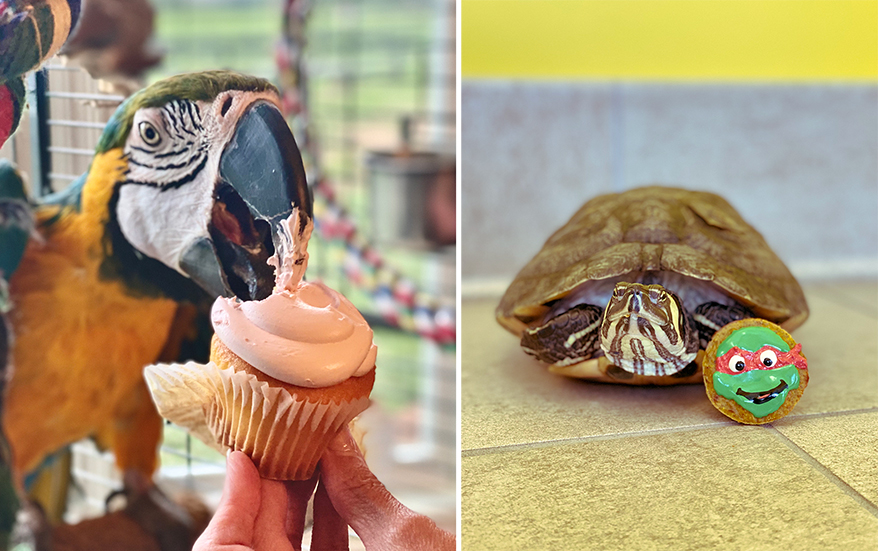
Max, right, and Squirtle left get bakery treats made just for them at Dog Krazy.
4. Think Outside The
Species When Selling…
Park also sells cat food and treats — Stella & Chewy’s, Ziwi Peak, Vital Essentials and Savage Cat — to her ferret customers, as well as litter pans and beds. And dog toys are a hit with one customer’s ferret, in particular. “He loves to come in the store and crawl around in the Fluff & Tuff basket, so they ended up buying a toy for him to have as a companion.”
Nancy Guinn of Dog Krazy stores in Virginia recommends Absorbine’s Silver Honey for a variety of species based on personal experience. “I use it on my dogs and my pet pig. Jimmy Dean sometimes rubs his face on our coffee table, causing his skin to split near his eye. I put Silver Honey on it, and it heals in 24 to 48 hours.”
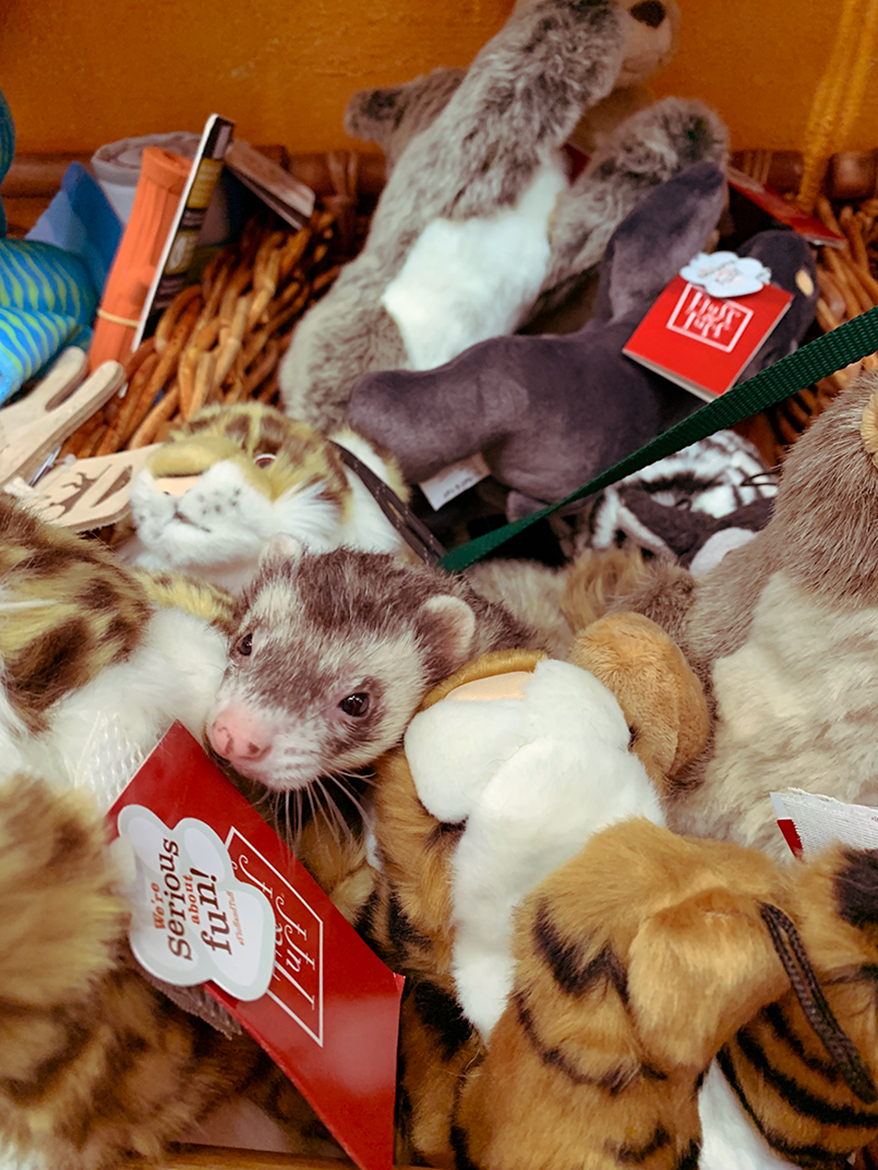
5. … And When Baking
Guinn also loves to make cakes for dogs and cats, but also has baked for birds, bunnies and even turtles. “Cakes can be altered to suit any species. It’s a similar recipe, I just swap proteins based on the type of pet.” Recent creations have included a cupcake for her own bird Max, plus a Teenage Mutant Ninja Turtle cupcake for Squirtle the turtle.
6. GoWild!
Who doesn’t have wild birds visiting their home? Lisa Boegl of Eldorado Country Pet in Santa Fe, NM, understands this and says, “I sell a ton of wild bird seed and supplies!” She carries seed from Kaylor of Colorado, Wild Delight and Better Bird, and hummingbird feeders from Aspects HummZinger and Best-1. “If you’re not sure this category will work well in your store, start small. Bring in some suet and suet feeders. Not a huge investment for you or your customers. If that goes well, look at seed blends and straight sunflower seed. If that goes well, bring in some feeders: tube feeders, tray feeders, etc. That’s where you make the money. Once you become a reliable and knowledgeable source to your customers, you’re good! I also offer an in-store frequent-buyer discount for wild bird seed, same as my dog and cat programs.”
Sarah Adams at The Raw Connection in Carmel, CA, also has found success with wild bird seed. She dedicated a set of shelves in her dog training room to Volkman Pet Products, and then COVID hit and opened up the entire room for use. “We added 58 feet of shelving, which takes up about half of our 1,500 square foot room. We now order two to four 2,000-pound pallets of seed each month. Our sales revenue for just the wild bird and small animal seed from Volkman was over $50,000 in 2020. We already surpassed that number in August 2021. The transition to wild bird seed and other animal feed was one of the best decisions we could have made. Having wild bird seed has brought additional customers in for our dog and cat food business, and many of our existing customers are happy that they can now buy wild bird seed from us.”
Advertisement
7. Be Special
Special order and publicize that you do via email, social media and on delivery flyers like Kelly Newton of Nickel City Pet Pantry in Getzville, NY. She has dog customers who also buy Guinea pig food and hay from her store. “I order regularly from Pet Food Experts, so it’s easy to throw on a few extra products here and there. In those cases, where I’m already delivering to the customer, I’m happy to match Chewy’s price. I only order for a handful of customers and it’s not especially profitable for me, but I view it as an ‘add-on’ item. It’s always a win if I can get a customer to shop local instead of ordering through Chewy or Amazon, and it increases their average order value.”
8. Fill A Void
When a large chain closes in your neighborhood, bring in what they carried. Michael Morris of Yarn & Bone Pet Supply in Camden, DE, did this when he moved his store into a former Pet Value location. “We started with small animal and reptile supplies, and quickly added a bird section,” he says. Oxbow and Rosewood are favorites for small animal, ZuPreem for bird and ZooMed for reptile. “It’s a growing area in the store since we’ve listened to customers on missing items.”

9. Carry Feeders
Liz Harris of Creatures Featured in Madison, FL, says “If your dog and cat customers have reptiles, carrying feeders is an easy way to dip a toe into exotics. Live feeder customers are a loyal bunch if you can provide what they want on a regular basis.
Banded crickets, mealworms and superworms are a good mix to start. Finding suppliers of healthy insects that can get them to you in good shape is key. You will probably try a few sources to find out how the logistics work for your store. Also be prepared to have more than one vendor because of product availability. Sometimes there are shortages of one type of bug or another.”
For snakes, she opts for frozen rodents, as does Jennifer Marshall of Northwoods Pets in Rhinelander, WI. “We use a breeder out of Milwaukee, but there are options for frozen rodents all over the country. We prefer to go smaller as the rodent quality tends to be much better.” She also keeps a digital kitchen scale handy for weigh-ins, shown above, which she says are “especially important for snakes, as feeders for ball pythons are typically based on weight.”
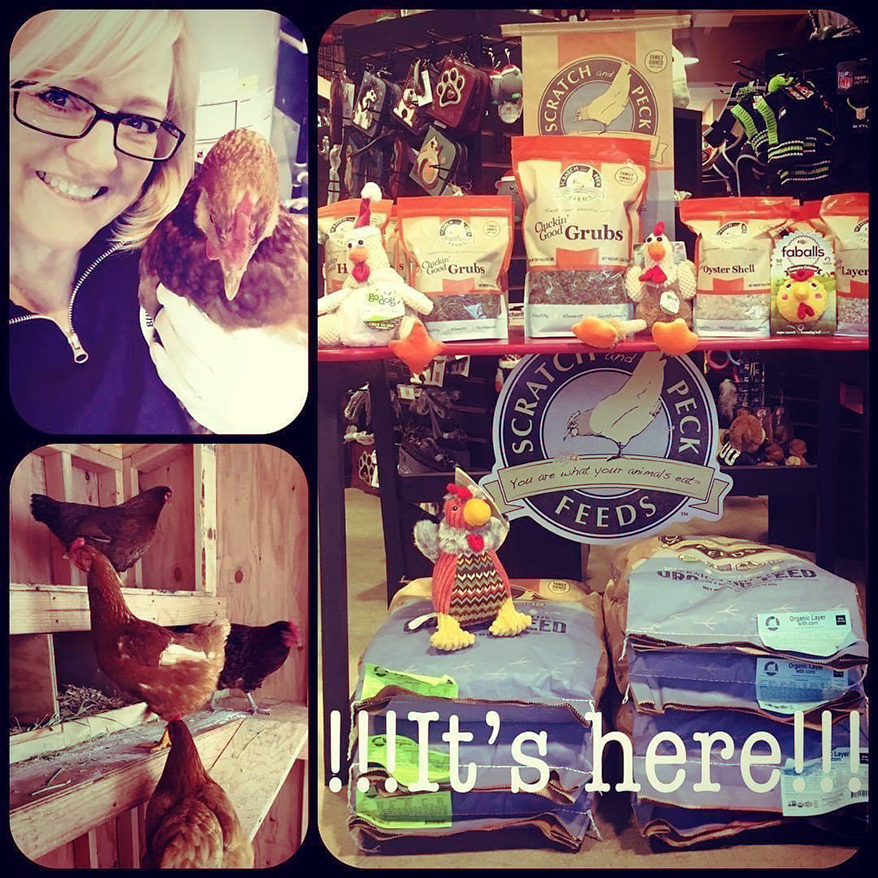
Julie Sterling saw a huge surge in backyard chicken ownership in 2020 and has been more than happy for Julz Animal House to meet the need for feed.
10. Carry Feed
Backyard chickens also have seen an increase in popularity during the pandemic. Julie Sterling of Julz Animal Houz in Marysville, WA, carries organic Scratch & Peck feed. “Our customers view their chickens as pets, much the same as they do their dogs and cats, and having a store where they can grab food for all three has helped to increase sales and promote one-stop shopping.” She recommends negotiating with a brand if bringing in feed. “I started special ordering for this one customer, but found that the margin was miniscule because the distributor I had to purchase through catered to large farm and feed stores that could order in much larger quantities. I spoke with Scratch & Peck and a local distributor, and facilitated the allowance of Scratch & Peck to be dual distributed, which allowed me a better price. Once I was able to obtain a lower price, this brand became much more worth bringing in as a regularly carried item, and it snowballed from there. Chicken feed is our biggest non-dog/non-cat diet.”
11. Market Through
‘Other Pet’ Groups
Kendra Conze of Health Mutt in Tampa, FL, also carries chicken feed from New Country Organics. She brought it in for her own chickens, then grew demand for the product through posts in the Seminole Heights Backyard Chickens group on Facebook. “It’s another fun way to get customers to come check us out.”
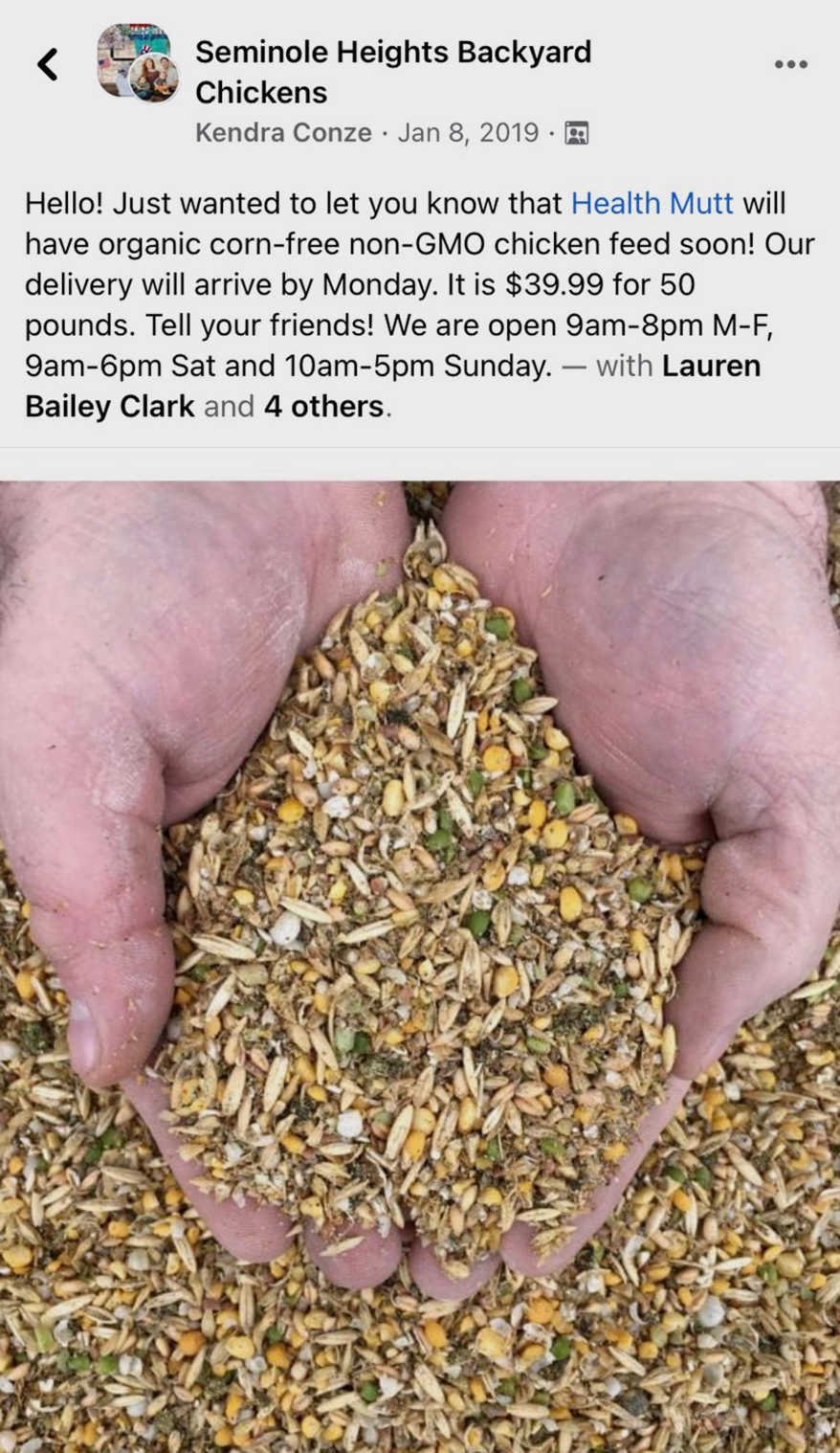
12. Create A Box
Sarah Ybarra of Lucky Dog Pet Grocery & Bakery in Lawrence, KS, recently launched Pincher Pal, a subscription box for hermit crabs. The bi-monthly, themed boxes contain decor, food or supplements, crabitat necessities, and cookies baked at her store — all thoroughly researched to be appropriate for the pets and tested by her own Frodo and Bilbo Crabbins. Information about how each product benefits hermit crabs, care tips and hermit crab-themed gifts for humans also are included. “Hermit crab people will spend $300 on supplies at a store and up to $100 a month on food,” Ybarra says. “This was an untapped market waiting for someone who owns a pet store.” Subscriptions doubled from 15 to 32 between the first and second boxes, and she sees significant growth potential as hermit crab enthusiasts out of state and even the country sign up. Ybarra also promotes adoption or purchasing from a hermit crab breeder, as opposed to removing them from the wild as big-box stores do.
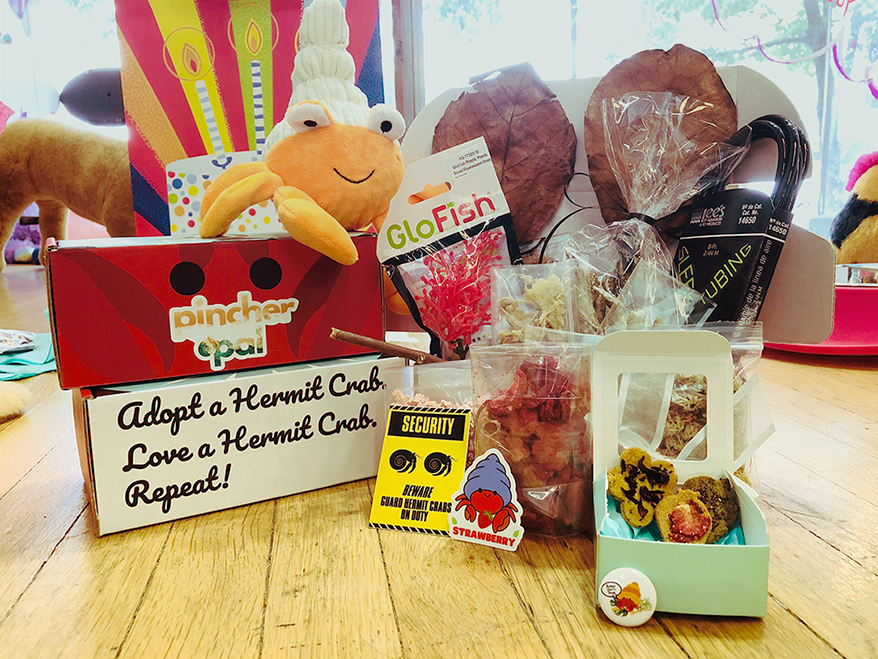
Above, the Pincher Pal subscription box pleases pet hermit crabs and people alike.
13. Welcome ‘Other
Pets’ For Grooming…
With veterinarian appointments at a premium these days, ‘other pet’ parents are looking elsewhere for grooming services. Tammy Breckenridge of Bark Dog Spa and Boutique in Athens, GA, let local vet offices know that she offers small animal nail trims and grooming. She learned how to groom Guinea pigs from a friend who shows and raises them. “Finding a breeder is a great place to start,” she says to those looking for specialty instruction. “We use human nail trimmers for small rodent nail trims, always making sure we have Kwik Stop on hand in case we cut too close to the quick. A fine-tooth comb, soft slicker, and small shears for trimming long hair work best. And we try to have a dedicated time, usually early evening when most of our dog clients have left, so it’s less stressful.”
Kelly Ross of Woof Gang Bakery & Grooming The Woodlands in Tomball, TX, also offers small animal nail trims as well as rabbit grooming. She says “Quite a few of my groomers have come from PetSmart, so they are good with small animals.”
Paige Elder of Buzz n’ B’s Pet Shop in Erie, PA, points out how profitable it can be to offer these services. She brings in about $1,000 a month with small animal and reptile nail trims. The only costs: $4.93 a month for styptic powder and $4 every six months for trimmers. “Trims do usually require two people, but only about five minutes at most per animal.”
Advertisement
14. …And For Boarding
If dogs and cats board at your business, also consider welcoming small animals. Natalie Bosch of Albany Pet Hotel in Albany, OR, recommends advertising online if you do. Her boarding facility regularly cares for Guinea pigs, rabbits, ferrets, chinchillas, rats, hamsters and gerbils, with business picking up significantly this year. “There are a lot of people searching online for places to take their exotic animals. We clearly lay out pricing and services on our website as well as on our social media.” She also advises separating these pets. “We have dedicated areas in the building to house exotic animals away from the dogs, which is very important to our clients. A lot of clients prefer to have their small animal out of their cage during the day, which we’re able to accommodate since our exotic rooms are separate from where our dogs and cats stay.”
15. …And For Pet Sitting
Create shorter visits for “other pets” who don’t require as much care as dogs and cats. Amber Van Denzen Suarez of Atta Boy! Animal Care Pet Sitting + Dog Walking in Mulberry, FL, spends 15 minutes with small animals, birds, fish, reptiles and amphibians for $20. Typically this involves refilling food and water, but occasionally giving medications. She offers this advice: “Ensure you have knowledge of each creature you are caring for to be able to notice any ‘yellow’ or ‘red’ flags that may arise.” Atta Boy! regularly gets referrals from exotic vets.
Ashley Cook of Viva La Pet in Dover, NJ, also offers shorter visits and has a tank for turtles in her home. “We have the clients bring the turtles over. We feed them pellets and check on them until the clients are ready to pick them up!”
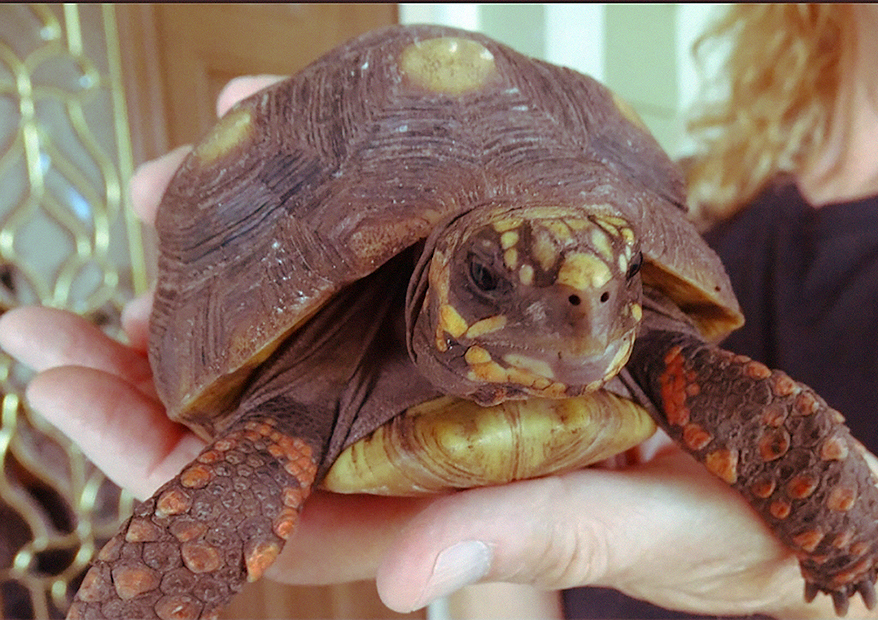
Atta Boy! Animal Care Pet Sitting & Dog Walking keeps an eye on “other pets” as well.
16. …And To Events
When taking pet portraits at your business, be sure to invite all. Ron Keller of Captivating Canines in Westerville, OH, has had snakes, turtles and even a skunk.
17. Offer Classes
NorthPoint Pets & Company in Cheshire, CT, recently invited vet tech Morgan Hunt to lead a free small animal workshop. Owner Nicole Cammack says, “We noted a lot of customer questions on care, feeding and overall lack of knowledge on some of the best practices. We offer a wide array of high-quality items, but if small animal owners didn’t know how or why some of the details were important, we knew we needed to provide more information. Morgan covered everything from proper diet, the ratio of fresh food, the right types of hay, destructive/bored behavior, exercise and needs at different life stages.” The class reached multi-pet households who didn’t realize the store catered to small animals.
18. Go Beyond & Big
When Samantha Youngblood’s beloved horse Duke developed emphysema, “We were told if the medication didn’t work, then euthanasia was the only option. I was determined to help him naturally and hired a certified equine sports massage therapist to come out and work on him. After one session, I immediately saw improvement and thought, I want to do this! She helped me find a school and get started, and the rest is history!” Youngblood Animal Massage, co-owned and operated by Samantha and mother Kim, has as clients horses, sheep, cattle and hogs, in addition to dogs and cats. “Being able to serve a host of clients of different species has been amazing. It has taught me so much, and being able to widen our services and offerings has been extremely beneficial to our business. We are not a ‘one trick pony’ and can serve many. If we don’t know the answer or feel like we aren’t the right fit, we refer our clients out or reach out to another therapist for advice or a joint consultation. Because of this mentality, we are able to meet and interact with a variety of awesome, talented, enthusiastic and highly educated individuals who have helped us grow our business and our clientele.”
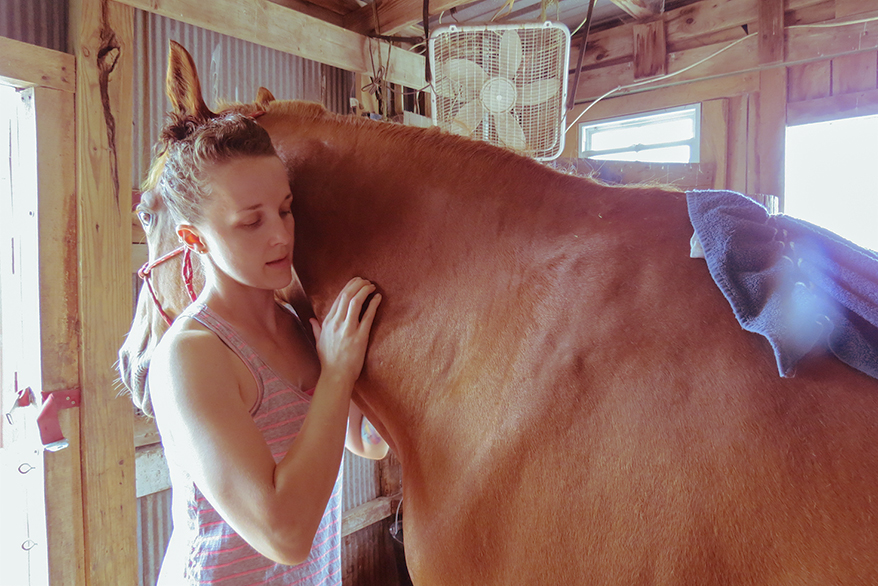
Samantha Youngblood with her favorite equine client, Duke.
19. Ask Favorite Brands
What Else They Do
Many dog and cat brands also have gone beyond. Chelsea Sher of Evanger’s Pet Food says, “Our ferret parents were reaching out for more information on our grain-free game meats. We took a look at the research done on ferret nutrition and realized not only is there little research, but the foods that were available, based on the nutritional requirements of a ferret’s system, were quite poor. Evanger’s ferret foods provide high meat content that meets the nutritional needs of obligate carnivores, and contain no grain, filler, or added carbs that can shorten lifespan.”
Scout & Zoe’s introduced SuperFly this year. While the company has focused mainly on dogs, cats and birds, owner Cindy Dunston Quirk promotes the new black soldier fly treats, toppers and oil as sustainable protein for reptiles, amphibians and chickens. She also gives “Keep Bugging Me” bumper stickers to retailers.
20. Know When Not
To Go Beyond
The response, “How do you go beyond dog and cat?” was overwhelming — but in a good way! Some Brain Squad members offered short bits of practical advice, while others wrote entire chapters on their areas of expertise. At petsplusmag.com/beyonddogandcat, you will find articles from Rhonda Olson of Rhonda’s Aviary in Milton, FL, and Paul Lewis of Birds Unlimited in Webster, NY, on how to properly groom and board birds. And Harris of Creatures Featured goes into great detail on the ordering and care of live feeders for reptiles and amphibians. Plus others!
Advertisement